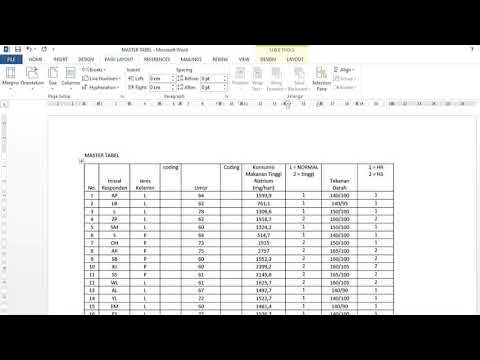Tutorial Vector Error Correction Model (VECM) dengan Eviews FULL
Summary
TLDRThis tutorial guides viewers through the process of applying the Vector Error Correction Model (VECM) in EViews to analyze the relationship between the Financing to Deposit Ratio (FDR) and Non-Performing Financing (NPF) in Indonesian Islamic banks. The video covers data input, stationarity testing, optimal lag selection, Granger causality, cointegration testing, and VECM estimation. It also explains the significance of long-term and short-term relationships, impulse response functions, and variance decomposition. The tutorial provides a comprehensive, step-by-step approach to understanding and using VECM for time series analysis.
Takeaways
- 😀 The Vector Error Correction Model (VECM) is used for analyzing the relationship between variables that are cointegrated, such as FDR and NPF in Islamic banking.
- 😀 Before applying VECM, ensure that the data is stationary. Use unit root tests (Augmented Dickey-Fuller) to check for stationarity at both the level and first difference.
- 😀 If the data is non-stationary at the level, difference the series until it becomes stationary at the first difference.
- 😀 The optimal lag length for the VECM model is determined using the Akaike Information Criterion (AIC). The lag length with the lowest AIC value is selected.
- 😀 A stable VAR model is crucial for accurate analysis. Check stability by examining the modulus of the roots, which should be less than 1.
- 😀 Granger causality tests help identify the direction of causality between variables like FDR and NPF. A p-value smaller than 0.05 indicates a causal relationship.
- 😀 Cointegration tests (Johansen's method) assess long-term equilibrium relationships between variables. If cointegration is found, proceed with VECM estimation.
- 😀 In the VECM estimation, both short-run and long-run relationships between variables are analyzed. Short-run relationships focus on immediate adjustments, while long-run relationships reflect equilibrium conditions.
- 😀 Impulse Response Functions (IRF) analyze how shocks in one variable (e.g., NPF) impact another (e.g., FDR) over time.
- 😀 Variance decomposition shows the proportion of the variance in a variable (e.g., FDR) that can be attributed to shocks in itself and other variables (e.g., NPF) over multiple periods.
- 😀 The tutorial emphasizes practical steps in using EViews for VECM, including data import, testing for stationarity, selecting lag length, and interpreting model results for real-world economic analysis.
Q & A
What is the Vector Error Correction Model (VECM)?
-The Vector Error Correction Model (VECM) is an extension of the Vector Autoregression (VAR) model used to analyze cointegrated time series data. It helps to model both the short-term dynamics and long-term equilibrium relationships between variables.
Why is stationarity important in time series analysis?
-Stationarity is essential because most time series models, including VECM, require the data to be stationary. Non-stationary data can lead to misleading results. Stationary data has constant statistical properties over time, making it suitable for modeling and analysis.
What is the first step in conducting a VECM analysis?
-The first step is to check for stationarity using a unit root test. This involves testing if the data is stationary at level or if it needs to be differenced (i.e., made stationary at first difference).
What happens if the variables are not stationary at the level?
-If the variables are not stationary at the level (i.e., their p-value is greater than 0.05), they need to be differenced to achieve stationarity at the first difference. Only stationary data can be used in further analysis, such as VAR or VECM.
How do we select the optimal lag length in a VAR model?
-The optimal lag length is selected based on criteria like the Akaike Information Criterion (AIC). The lag length that minimizes AIC is typically chosen, as it strikes a balance between model complexity and fit.
What is the purpose of the Granger Causality Test in VECM analysis?
-The Granger Causality Test is used to determine whether one variable (such as FDR) causes or influences another (such as NPF) over time. It helps identify the direction of causality between variables.
How can we confirm if there is a long-term relationship between FDR and NPF?
-We can confirm a long-term relationship between FDR and NPF by conducting a cointegration test. If the p-value is less than 0.05, it suggests that the two variables are cointegrated, indicating a long-term equilibrium relationship.
What is the difference between long-term and short-term effects in VECM?
-In VECM, the long-term effect refers to the stable, long-run relationship between variables (cointegration), while the short-term effects capture the immediate, dynamic interactions that may vary over time.
What is the role of impulse response analysis in VECM?
-Impulse response analysis helps assess how a shock or change in one variable (e.g., FDR) affects the other variables (e.g., NPF) over time. It shows the dynamic relationship between the variables.
What does variance decomposition tell us in a VECM analysis?
-Variance decomposition helps us understand how much of the variance in each variable is explained by other variables in the system. It reveals the proportion of the total variance in each variable that can be attributed to shocks or changes in other variables.
Outlines

هذا القسم متوفر فقط للمشتركين. يرجى الترقية للوصول إلى هذه الميزة.
قم بالترقية الآنMindmap

هذا القسم متوفر فقط للمشتركين. يرجى الترقية للوصول إلى هذه الميزة.
قم بالترقية الآنKeywords

هذا القسم متوفر فقط للمشتركين. يرجى الترقية للوصول إلى هذه الميزة.
قم بالترقية الآنHighlights

هذا القسم متوفر فقط للمشتركين. يرجى الترقية للوصول إلى هذه الميزة.
قم بالترقية الآنTranscripts

هذا القسم متوفر فقط للمشتركين. يرجى الترقية للوصول إلى هذه الميزة.
قم بالترقية الآنتصفح المزيد من مقاطع الفيديو ذات الصلة

Regresi Data Panel Eviews 12 Lengkap dengan Penjelasannya

Manajemen Pembiayaan Bank Syariah Bagian 1 | Rais Sani Muharrami, M.E.I

Entenda o Financiamento de Construção em Terreno Próprio | Atualizado 2024

Uji Statistik Chi Square dengan tabel 2X2. cara membaca hasil uji chi square.

Digital Lending Trends Over the Next 3 Years | Bharat Fintech Summit 2023 | The Digital Fifth

Sesi 6 Pengantar Bisnis
5.0 / 5 (0 votes)
